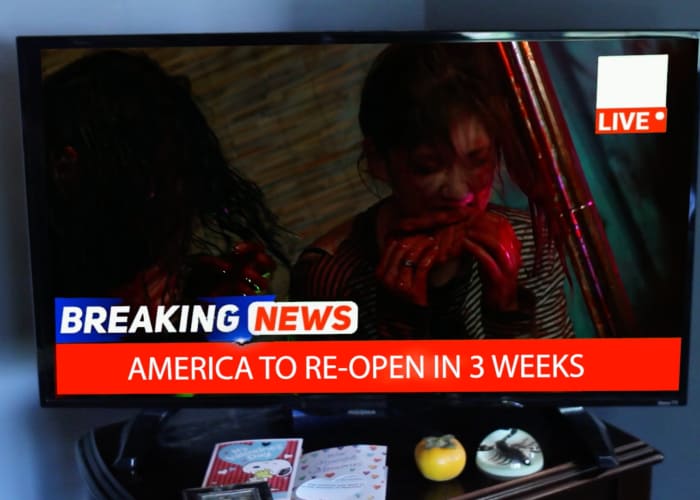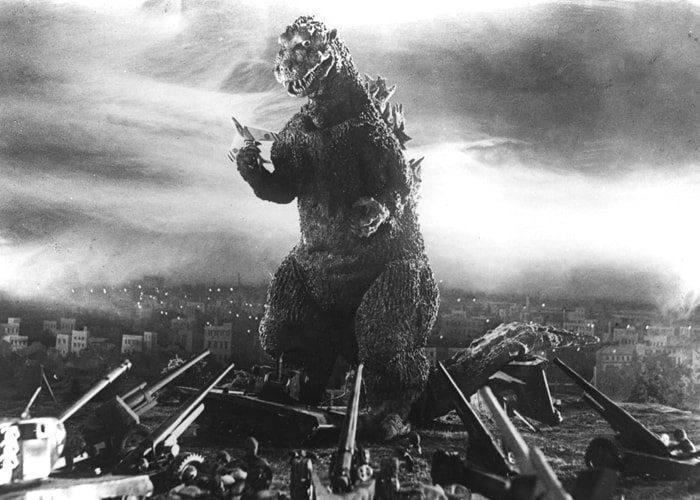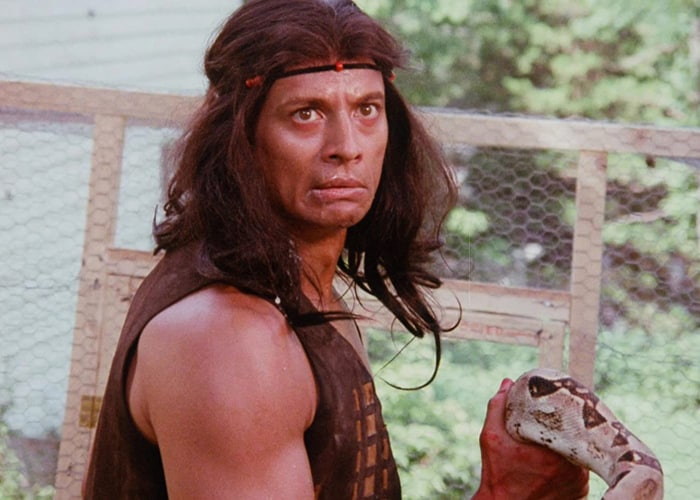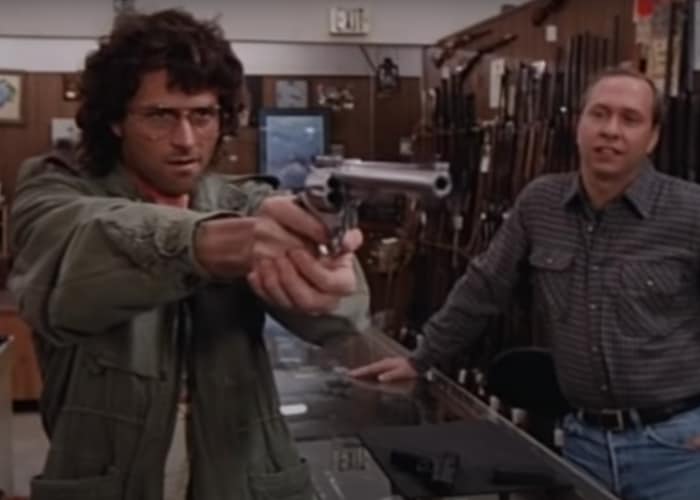When Charles Band and Full Moon Features announced Corona Zombies, the internet threw a bit of a fit. Chris Alexander, the writer/director/musician and an all-around good dude who works closely with Band on his various ventures, shared the news on his Facebook page and was met with a collective response of “now is not the time.”
Full Moon describes the film as “part irreverent satire, part gonzo Italian zombie movie remix,” and sells it as a horror-comedy that features “inept world leaders” and “mass-media gone wild.” The tagline sums up the overall silliness of the project: “They’re Coming to Wipe You Out!”
There’s no denying that this was intended to be a quick cash grab, at least to some degree. After all, Band is nothing if not a businessman. And he did take a cheap approach, but a rather smart one. The majority of the film, which barely runs over an hour, is repurposed footage. Large chunks of Bruno Mattei’s Hell of the Living Dead are re-dubbed and mixed together with scenes from Zombies Vs. Strippers while clips of real-world news footage and Donald Trump press conferences are sprinkled in. The only new footage features Cody Renee Cameron as a ditzy blonde named Barbie who learns of the coronavirus outbreak via the news.
The approach, which is similar to the films What’s Up, Tiger Lily? and President Wolfman, works well. Band manages to craft a coherent story about how a company’s attempt at creating bat soup causes the deadly outbreak. A SWAT team known as the Corona Squad is tasked with tracking down a solution. The final result is a gory gut muncher that is mostly funny and sometimes stupid. At one point, after his young child is bitten, a man looks at his wife and says, “There’s too much biting in the public school system.” I just about died, because I, was in fact, bitten in the third grade while attending public school.

The over-the-top satire takes on the incompetence of the world leaders that have allowed COVID-19 to spread while also making sure to take on the protestors who think social distancing is more detrimental than the deadly pandemic. At the same time, Corona Zombies lovingly pokes fun at the very Italian zombie genre it’s remixing. Think of it as an episode of Mystery Science Theater 3000 with a coronavirus slant. And it’s far less exploitative than it appears on the surface.
Still, it’s not surprising that the film has rubbed some people the wrong way. For starters, it’s a Charles Band movie and Charles Band tends to have that effect on people. More importantly, the coronavirus pandemic is an ongoing issue that is actively destroying lives, and it’s not entirely clear when it will end. Asking if Corona Zombies is a movie that needs to be made now is a fair question. To answer that, though, we can take a look at the history of exploitation cinema.
In her 1965 essay “The Imagination of Disaster,” Susan Sontag discusses this very topic. About the science fiction films of the ’50s and ’60s, she writes that these films have the ability “to lift us out of the unbearably humdrum and to distract us from terrors” and “normalize what is psychologically unbearable.”
The movies Sontag is referring to are those in which nuclear radiation, or something similarly real or possible, alters Earth in devastating ways. This could be awakening giant creates living deep within Earth’s core, causing freakish mutations, or simply destroying the planet. These are the films that followed the end of World War II and were ushered in by the Atomic Age and the Cold War.

The most famous of these is Godzilla. Ishirō Honda’s landmark film was a direct response to the terrors of nuclear weapons. The central plot involves the historic beast being woken from his underwater slumber as a result of hydrogen bomb testing in the Pacific. Japan was fearful of what further atomic warfare could bring while still trying to recover from the aftermath of the Hiroshima and Nagasaki bombings that had occurred just nine years earlier. These days Godzilla is celebrated as a fun monster flick, but it’s a rather somber tale about the fear of another nuclear attack and uses a destructive monster and dark humor to ease the pain.
Released a few months before Godzilla, the science fiction film Them! is perhaps America’s greatest entry into the monster craze of the ’50s. The creature feature about giant mutated ants in the deserts of New Mexico is a popcorn classic. The exterior might be that of a B-movie, but at its core, Them! is a cautionary tale about the effects of the nuclear testing that was being conducted in the state.
The Day the Earth Caught Fire, released in 1961, is a bit more on the nose. In the film, the United States and Russia both test atomic bombs at the same time and the ensuing chaos knocks the Earth’s rotation off its axis. Rather than hide behind the creation of a monster, the film portrays humans as the party solely responsible for the world’s impending doom.
The late ’60s and ensuing decades saw atomic scare movies drop in popularity. New ones were still released on occasion, but they became more sporadic. As the fear of nuclear war died down, the ’70s saw a rise in exploitation movies based on true crime events.

In late 1970, director David Durston was developing a script about a small town being overrun by a rabies epidemic. While completing the script, he was paying close attention to the trial of Charles Manson, which inspired him to create a character who is a Mason-like leader. The final product, I Drink Your Blood, is a groovy bloodbath about a sadistic gang of hippies who terrorize a small town to appease their leader.
Tom Hanson’s The Zodiac Killer is a sleazy slasher released in 1971 while the real Zodiac Killer was still wreaking havoc around San Francisco. The movie takes great liberties with the facts and wouldn’t stand out from any other low-grade slasher from the era if the plot revolved around a fictional killer, but it is notable in that it was part of an elaborate plan Hanson hatched to catch the killer. “I thought he’d go see a movie about himself. He’d have to,” Hanson says in a 2017 interview with Mental Floss.
A lesser-known example of exploitation taking on current events of the time is 1988’s Bloody Wednesday. This film tells the story of a man that plans to open fire at a crowded fast-food restaurant after losing his job. While the facts are heavily altered, the film is based on the San Ysidro McDonald’s Massacre, which had occurred four years earlier and, at the time, was the deadliest mass shooting in US history.
On May 23, 1993, NBC aired the action drama In the Line of Duty: Ambush In Waco. This made-for-TV movie chronicles the events leading up to the siege on the Waco compound belonging to the Branch Davidians. The siege lasted 51 days and resulted in the death of 76 people. The film was produced as the siege was ongoing and released a little more than a month after the deadly events. Tim Daly stars as the religious cult leader, David Koresh.

In October of 1999, just six months after the shooting at Columbine High School in Colorado, Duck! The Carbine High Massacre was released. The extremely low-budget film, directed by William Hellfire and Joey Smack, follows a pair of friends who, after getting picked on at school, form a plan with the school’s janitor to kill their fellow classmates and then commit suicide. The controversial film ended up getting the filmmakers tossed behind bars for possession of weapons on school property.
In 2011, Steven Soderbergh released Contagion. The film’s plot centers around a deadly virus spread via respiratory droplets. The CDC desperately tries to find a cure as the world panics. The film was inspired by two real-life pandemics; the 2002-2004 SARS outbreak and the H1N1 outbreak of 2009.
Nearly a decade later, pandemic movies like Contagion have seen a surge in popularity thanks to COVID-19. Vulture, Yahoo, and even we here at FSR, have written about the best pandemic movies currently available to stream. Soderbergh’s film has been the biggest beneficiary, however, with some declaring it a “must-see movie during the coronavirus pandemic,” and the film’s stars recently shared their advice on how to deal with the current virus. Our own Ciara Wardlow dug into its scientific relationship to the novel coronavirus.
This brings us back to Corona Zombies and the question about whether or not now is the time for such a movie. Given the current demand for pandemic-related films, a case could be made that now is the perfect time to make Corona Zombies. That doesn’t mean it’s not in bad taste, but that’s for the individual viewer to decide. And even if it is in bad taste, that doesn’t inherently make it a bad movie.
If you’re upset about Corona Zombies, you should let it be known. That’s your right. But you shouldn’t be surprised. Not because it’s a shlocky Charles Band movie, but because the history of cinema is littered with filmmakers exploiting real-world tragedies for inspiration. More films about the coronavirus are sure to come. Some will likely come from big studios with big budgets and a prestigious director attached. Some may even be met with great praise and generate awards buzz. But their origins will be no different than Corona Zombies.
0 comments:
Post a Comment